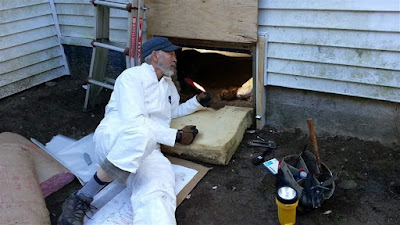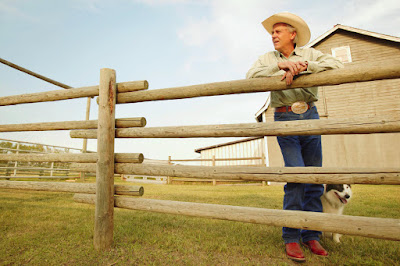© The Pew Charitable Trusts
Dave
Brown, 75, a volunteer for the Harpswell Aging at Home team, insulates the
floor under a house in coastal Maine. Volunteers in the graying state are
helping seniors remain in their homes.
HARPSWELL, Maine, October 26,
2016 — Dianna Haller loved her small, one-story home in this coastal fishing
town, but it didn’t love her back. The living room floor was sagging. Snakes
and mice were wriggling in through a gap under the front door. And mold was
seeping in through a crawl space full of standing water.
Haller, a 65-year-old widow
with chronic obstructive pulmonary disease who uses an oxygen generator, was
rushed to the emergency room several times this year because of breathing
problems her doctors said were exacerbated by the mold. She badly needed help,
but couldn’t afford the repairs.
Last month, the Harpswell
Aging at Home team came to Haller’s rescue. The group of volunteers in their
60s and 70s, dubbed the Dream Team, went to work insulating and shoring up the
floor, sealing the foundation, rebuilding the front door, installing rain
gutters and storm windows, replacing ceiling lights that were fire hazards, and
doing other work — all for free.
Across Maine, volunteers are
stepping up to help rural seniors like Haller who want to remain in their homes
as they age. Some work with local governments or nonprofits. Others have simply
gotten together to offer a hand. Many of them are seniors themselves.
And what they are doing can
be emulated by the rest of the nation, as the number of people 65 and over is
projected to explode from 48 million to 77 million between now and 2035.
John Cromartie, a U.S.
Department of Agriculture geographer, said the problems would be particularly
severe in New England, the Great Plains and Midwest farming states.
“The rural areas are the canary
in the coal mine,” he said. “In lots of cases, older people don’t have the
means to leave, even if they wanted to. And many want to stay because it’s
where they were born or settled down and raised a family.”
State governments face the same
dilemma. And retrofitting a house for aging people can be
expensive. It can cost $800 to $1,200 to widen a doorway to accommodate a
wheelchair, $1,600 to $3,200 for a ramp, and up to $12,000 for a stair lift.
That’s what makes Maine’s
growing volunteer network so valuable.
“There isn’t enough money in
Maine to deal with this problem,” said Jess Maurer, executive director of the
Maine Association of Area Agencies on Aging. “It’s going to have to be
community by community, using volunteers and public and private resources.”
Already, more than 60
communities throughout the state have started or are in the process of starting
programs to help seniors age in their homes, Maurer said.
Some volunteers offer rides.
Others grow and donate fresh fruit and vegetables. Some offer respite to
caregivers. And many, like the Harpswell Aging at Home team, perform home
maintenance or do chores that residents can’t do themselves.
Sandy Markwood, CEO of the
National Association of Area Agencies on Aging, called what’s going on in Maine
a model for other states.
“These are really small
communities doing incremental changes that make a huge difference to the people
who live there. They’re doing it with existing resources and the human capital
they have there.”
As in other rural areas, many
of Maine’s seniors live in multilevel homes without a bathroom or bedroom on the
first floor.
When they can no longer
drive, there’s little, if any, public transportation available, and grocery
stores, pharmacies and doctors can be far away. Experts say older adults who
stay in their homes often do less maintenance as the years go by, so their
houses often deteriorate.
“The challenges in rural
areas are probably the most severe,” said Susan Reinhard, a senior vice
president at the AARP Public Policy Institute. “Isolation is a serious problem.
Depression goes up. Physical health declines.”
For Haller, the Dream Team
not only improved her house but improved her health. She is breathing better
and hasn’t been to the hospital since they did the work. “You used to smell the
mold all the time,” she told volunteers who arrived to make more repairs this
month. “Now I can smell the salt air.”
At the Forefront of a Trend
In Maine, people
65 and over made up 19 percent of the state’s population last year, up
from 16 percent in 2010. And many state officials and advocates foresaw the
coming trend.
In 2013, the Maine Council on
Aging and House Speaker Mark Eves held a series of roundtable discussions about
the issue with leaders of business, finance, housing, philanthropy and state
and local government.
That provided a framework for
a summit on aging that drew 400 people in 2014, and resulted in the Maine Aging
Initiative, in which groups across the state try to come up with ways to tackle
the challenges posed by an older population.
Among the Initiative’s
recommendations: Urging communities to help the elderly remain in their homes.
Advocates for seniors in
Maine, New Hampshire and Vermont also share information about ways to help keep seniors
in their homes and beef up efforts to make communities more
age-friendly. The partnership is now working with more than a hundred
communities in the three states.
And in 2015, Eves, a
Democrat, and state Sen. David Burns, a Republican, created a legislative
caucus on aging. Since then, the Legislature has passed or funded 16 measures
to help older adults, including more funding for home-delivered meals and in-home care workers and expanded property tax relief
for seniors.
“One of our goals wasn’t just
to pass legislation, but to elevate the profile of these issues affecting our
aging population so people can take the initiative,” Eves said. “If you
fast-forward 10 years, I think Maine will have some lessons for other states,
particularly rural ones, about how to do it well.”
Lending a Hand
Many of the lessons in Maine
are to be found in the volunteer and civic groups that have sprung up or
stepped in to help seniors continue to live at home.
The Dream Team in Harpswell
was modeled after another home modification team, The Regulars, a group of
retiree Habitat for Humanity volunteers who have been helping seniors in
mid-coast Maine since 2014.
Last year, the John T. Gorman
Foundation gave Bath Housing, a regional housing authority, a $156,000 grant to
help seniors make home modifications. The agency used $69,000 from the grant to
contract with Habitat to expand The Regulars’ work.
Like the Dream Team, The
Regulars are an eclectic group of retirees, including a lawyer, an engineer, an
FBI agent and an English professor, who volunteer for Habitat.
They work twice a week, rain
or shine or snow — which is why they’re called The Regulars. They have taken on
60 jobs throughout the area.
They’ve done everything from
widening doors and fixing gutters to replacing floors to installing ramps.
Habitat pays for materials, trains the volunteers, and provides liability
insurance, staff support and a van with tools.
Many seniors who’ve gotten
help from The Regulars live in substandard housing or mobile homes, which often
are not insulated and can be freezing during long, cold Maine winters.
“One guy who had five bypass
operations had no heat. We got the furnace working,” said George Shaw, 76, a
volunteer. “We’re these people’s peers. We make them feel like they’re being
helped by their own community.”
Kathy Smith, development
director for Habitat for Humanity-7 Rivers Maine, said it’s not just rural
seniors living in modest homes or trailers who need help. The group has
assisted people who live in larger houses that are worth more, but don’t have
the income to maintain them.
The Village Lodge Handy
Brigade, run by a team of Masonic lodge brothers whose ages range from 19 to
the mid-70s, assists seniors in the small farming town of Bowdoinham and in two
other towns with everything from changing lightbulbs and installing smoke
detectors to replacing storm windows and making minor carpentry fixes.
“This program helps people
maintain their independence and keeps their property from deteriorating,” said
Peter Warner, 60, the Masons’ lodge master.
Warner said that since his
team, whose motto is “One light bulb at a time,” organized in February, it has
helped about 30 seniors. On a recent fall day, two team volunteers visited the
home of a grateful 76-year-old woman and her disabled sons to replace ceiling
tiles in a bathroom ruined by a plumbing leak.
“Older folks don’t want to be
seen as needing help, but with the Handy Brigade, they know of them and may
even have someone in their family who was a Mason,” said Patricia Oh, who coordinates
senior services for Bowdoinham and works with the team.
‘Life Experience to Share’
Cumberland is another Maine
town committed to helping seniors remain in their homes. It budgets about
$50,000 a year for an aging in place initiative that includes a program that
sends trained volunteers to spend time with seniors who feel lonely or who live
with a caregiver who needs a break.
Susan Gold, the town’s Aging
in Place coordinator, said the program offers social and psychological support,
and isn’t income-based. “Providing a friend isn’t something you can buy, even
if you have a million bucks,” she said.
For Brian and Judy Hathaway,
both 76, a weekly visit from volunteer Heidi Kleban makes a big difference.
Judy Hathaway suffered a
stroke nearly 10 years ago. She has difficulty communicating and often gets
frustrated. Her caregiver husband said he desperately needs some time away, and
when Kleban visits he can take off and know his wife is having a good time
playing cards or taking walks. “Heidi comes in and Judy just melts. She loves
her,” he said.
Kleban, 46, said she
volunteers because she enjoys the company of older people. “They have a whole
life experience to share,” she said. “And besides, who else would have taught
me gin rummy?”








